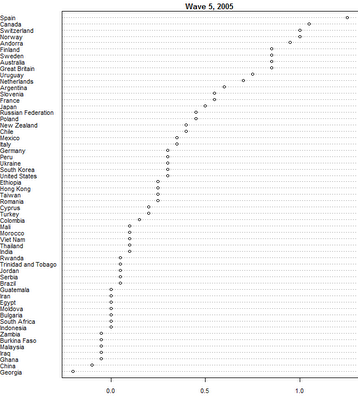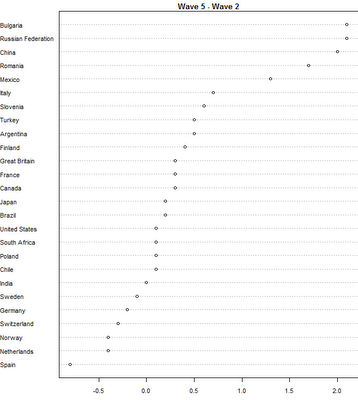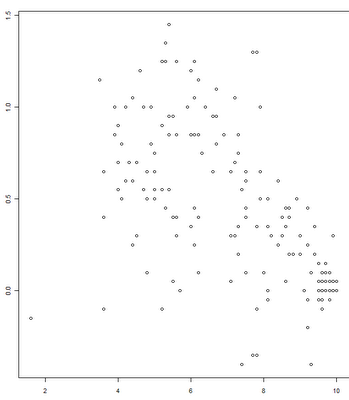|
Wednesday, October 28, 2009
Many nations are getting more religious, but young people are still less religious
posted by
Razib @ 10/28/2009 12:13:00 AM
One thing that has bothered me, or at least piqued my interest, are two seemingly contradictory facts:
1) Many regions & nations have seen a resurgence of religion in the past generation (i.e., 1980s to 2010). The post-Communist and Islamic world most prominently. There is quantitative data for the post-Communist world, while for the Islamic world it is more impressionistic (e.g., the shift toward more stark outward "conservatism" in dress among the young). 2) But The World Values Survey does not show a skew toward religiosity among the young for most nations. Very few in fact. This is a bit curious in light of some plausible background assumptions. For example, religious people have more children the world over within each nation (though religiosity at the national level may have a more unpredictable relationship to fertility, as evident in Western Europe). I decided to present the data which I'm basing the second assertion on. The WVS has several "waves." I decided to look at wave 5, wave 4 and wave 2, which were done during the mid to late 2000s, around 2000 and 1990 respectively. I also looked at the question: How important is God in your life? Please use this scale to indicate- 10 means very important and 1 means not at all important. The WVS interface outputs mean values (as well as standard deviations). You can then drill-down and cross with age of the respondents in 3 classes:, 15-29, 30-49, and 50+. I was curious as to age related changes, so I simply put the mean values of the importance of God by age class into the linest function. So, if the mean values were 7, 8 and 9 for the age classes from youngest to oldest, the linest would output a slope of 1 as I omitted x values (so the classes would be recoded implicitly as 1, 2, 3, etc. for x's). If you reversed it, it would output -1. So, negative values indicate that the younger are more religious than the old. Here are some trends in the data..... Here are some charts ordered by the values generated by linest by wave. The countries at the top exhibit larger differences between the young and old. Observe the large asymmetry in the number with positive vs. negative values (that is, many more nations have more secular young than old). You need to click to see the larger version.    Some of the nations span the waves (many do not). 30 nations span wave 5 and wave 4. Here are the correlations between the same columns across waves: Mean religiosity = 0.98 Trend of religiosity by age = 0.84 I don't know if the samples are representative (though the developed world ones do seem to be, I've checked with independent surveys and they often match up well), but the two waves seem consistent with each other here. Now let's compare wave 2 and wave 5. So from from ~1990- to ~2005. Mean religiosity = 0.92 Trend of religiosity by age = 0.77 How about differences in mean religiosity from wave 2 to wave 5? Here we see a bias toward greater religiosity in the 26 countries found in both waves.  The results match expectation. The nations to the right, those which have seen the most increase in religiosity are post-Communist ones. No surprise there. The nation furthest to the left is Spain, it's gone through the most striking shift toward secularism since 1990. That is in line with what the news reports, the position of the Catholic Church at the center of Spanish life has been collapsing since the 1980s (more accurately, since the end of the Franco regime). One assumes that the difference in religiosity by age cohort is a feature of less religious societies. If everyone is religious, as is the case in some Muslim and African countries, then there can't be any variance. Merging all 3 waves together, here's a scatter plot which shows the trend:  Now a labelled plot of wave 5.  An interesting point of contrast is China and Spain. In the 1970s Spain was still a pro-clerical right-wing authoritarian regime, while China was an atheist left-wing regime. Political pressures toward conforming to a particular attitude toward religion have abated in both nations over the past generation, and while Spain has become much more secular, China seems to more religious. The mean value of the importance of God in one's life in China is 3.7 in the youngest age group, and 3.5 in the oldest (survey taken in 2007). In 1990 it was 1.5 and 1.8 respectively. The big test would be to see how the 15-29 compared to 30-49 between wave 2 and wave 5. I'm a little worn out by this right now, so I'll look at that systematically tomorrow (or the next day), but spot checking Russia seems to show that the rank-order holds, but all age cohorts became more religious (not relevant for the youngest cohort in wave 5 because they weren't surveyed in 1990). In Spain the 15-29 year olds in wave 2 who became 30-49 year olds in wave 5 are invariant. If you want to get a jump ahead of me, here are some raw data file (excel): religwave2.xls religwave4.xls religwave5.xls Here are two preliminary comments: * All the post-Communist nations have seen a resurgence in religion (perhaps with the exception of the Czech Republic). But this is a phenomenon which has "lifted all boats," older people who were militant atheists who went on anti-religious rampages in their youth have been swept along, just as generations who barely remember Communism exhibit the nominal culturally grounded religious sensibilities normal in many societies. I've read a fair number of news stories over the years about the generational "God-gap" in the post-Communist states, but I suspect that it makes a punchier story-line than to suggest that there's been a broader societal shift. That it isn't a case of atheistic pensioners vs. youthful churchgoers. * The Muslim countries are really weird. On most of the religious data in the WVS the only nations which approach or surpass them consistently are the African ones, and these do not exhibit the uniformity of outlook of the Muslim ones, especially the "core" Muslim nations of the Middle East. In some of the surveys for Pakistan no Pakistanis in a sample of 2,000 will admit to not believing in God, and in one survey all the respondents gave the highest value for the importance of God in their life on a 1 to 10 scale. By all, I mean all 2,000. It isn't implausible to me that somehow someone who was really religious just recoded the survey data to make Pakistan seem more religious than it was, but if so that bespeaks a zealous conformity of outlook in the society. But overall many of the Muslim nations are so religious that there isn't variation in belief by age group because there isn't variation much of belief, period. Everyone's on the same page. When you see women donning the hijab or men growing beards I think perhaps we should reconceptualize what's going on, as it isn't renewed orthodoxy (belief) as opposed to a change in orthopraxy. Of course it may be that Muslim nations do exhibit variation in religiosity, but they're just off the scale here. I suspect of the funniest shock-documentary projects would be to have someone run into a public square in the Muslim world screaming that God is dead. Of course, it might be a suicide mission! |



